Introduction
What follows is a story told in two voices. One is the myth of a stranded collector, Luthen Dune, an old wanderer in a post-apocalyptic desert, hiding a starship and trading poems for survival. The other is mine, Charles White, the real-world voice of a man stepping into character at Wasteland Weekend for the first time, where art, imagination, and dust converge.
This piece begins in fiction, carried on the words of Luthen Dune, and only at the end does the curtain drop. Along the way, you’ll walk through ruin and art, deception and survival, and perhaps find yourself asking what masks you wear—and what beauty you might choose to save.
[Image: The main gate of Wasteland leading into the city of the post apocalypse]
Prolog – The Wasteland Before Me
Every culture tells its end-of-the-world stories. Ours play out in cracked deserts, oil-starved caravans, floating citadels of rust and fury. We know their names: Mad Max, Waterworld, Tank Girl. Each imagined apocalypse takes what is familiar—roads, oceans, cities—and twists them into theaters of survival. Out there, hope is rationed, respect is fought for, and meaning is scavenged from the ruins.
But sometimes, those stories step off the screen. Every year in the Mojave, thousands gather to bring them alive. Wasteland Weekend is not just cosplay. It is an immersive city that rises from the desert, then burns itself away, leaving only dust and memory. In 2025, it marks fifteen years of existence, a milestone in a community that has learned how to turn fiction into survival and survival into art.
For me, this return to the desert feels familiar. Once, I built mutant vehicles and art projects for Burning Man. I helped craft moments of awe and laughter in the dust, channeling imagination into steel, fire, and story. Retirement has given me something I once lacked: time. And with that time comes the chance to channel that same creativity into a new myth.
This year I walk into the Wasteland as Luthen Dune—a persona born from my love of characters like Luthen Rael from Andor, filtered through the cracked-lens deserts of Dune and the scorched survivalism of Mad Max. He is an art dealer, a reliquary keeper, a poet of ash. A man with secrets, and a mission so much larger than the character he plays.
The stage is the Mojave. The curtain is already rising. What follows is not just a story, but a mask I wear, and behind it, a question: what truths can we reveal about ourselves when the world pretends it has already ended?
Here we go…
[Image: Drone image of Wasteland Weekend event by Mike Darling]
1. The Stranded Collector
I did not come here to live. I came to hunt. My mission was not blood or conquest but beauty… relics of a civilization already collapsing, fragments of a culture worth saving. I came to gather art, to carry it away from the flames, to return it home where it could live as testimony rather than ash.
Then came the pulses. Invisible, merciless, hammering across the sky. Were they born of war machines, the wrath of the sun, or weapons long forgotten? I will never know. What I do know is the sound of silence as my starship systems failed one by one. The stealth fields coughed out, the engines gave their last, and The Annex fell to gravity’s will. I eventually hid her in the canyon, her skin still humming with broken stealth, hidden from eyes that would strip her bare and leave me for dead.
[Image: Luthen Dune on the deck of The Annex working on a critical component.]
At first, I thought I had failed. I thought my mission ended when the stars closed their gates. But in time I saw something I had not expected. The tribes around me live by two currencies only: gas and bullets. They trade survival like it is the only thing that matters. Yet when I held up a carved bone, or painted the memory of a mushroom cloud, or spoke a poem beneath the firelight, they stopped. They stared. For a moment they remembered what their ancestors once knew: that life is not only endured, it is lived.
So I hunt still. Not only for my homeworld but for this one. I gather fragments of art and I make art anew. I scatter beauty like contraband into their hands so they might remember that meaning is just as vital as water. That a song can hold back despair longer than a ration of grain. That survival without spirit is no survival at all.
I came as a collector for the stars, but I remain as a collector for the people of the dust. Every scrap I find, every story I tell, every stroke of paint is a quiet rebellion against the tyranny of mere survival. And though I hide my ship, though I live as a wanderer, this much I know: art is the one cargo that can never be stolen, because once given, it takes root in the soul.
[Image: A cad drawing, 3/4 view, of a Fondor Class IV light transport/scout starship named “The Annex” #92172 owned by the Luthen Dune Company.]
2. The Fall of The Annex
The day The Annex fell is burned into me like scar-tissue. I had crossed the skies a hundred times before, wrapped in stealth so deep I might as well have been a ghost. But when the pulses came, as I was leaving Los Angeles, there was no hiding. They hammered down like the fists of forgotten gods. Invisible waves tore at every circuit, every shield, every engine breath.
One by one, my systems died. Warnings spilled across my console in a red chorus of failure. Power bled from the stealth fields, flickering like a candle in a storm. My engines stuttered, then howled, then choked in silence. I had no choice. To fight gravity was to die in fire. To embrace it was to hope I might hide her in cloak until I can get her fully repaired.
[Image: Emergency landing of the Annex in the open desert, while Luthen Dune uses the Annex Cart to scavenge for supplies.]
I was able to land in the open desert, but this was too dangerous as it was openly exposed. Eventually, with a few temporary fixes, I was able to get a few more small flight hops to navigate to an area more secure.
So I chose the canyon. Jagged walls, deep shadows, a place where the dust swallows sound and the sky rarely looks down. I guided her as far as I could, controls shaking in my hands, until the last surge of power gave way and she struck the earth like a wounded beast.
She survived. Not whole, not well, but alive. Her cloak sputters like a dying breath, still enough to blur her outline into stone and shadow. All systems shut down and routed energy to the failing cloak. But she is vulnerable. And if the tribes ever found her, they would not see a vessel—they would see a god. They would strip her skin for lightweight invincible armor, harvest her bones for weapons, worship her circuits and systems until nothing remained.
So I left her there, sleeping beneath the canyon walls. I carry her memory in silence, while above I walk the wastes. To protect her, I let the world see only my mask: a trader, a poet, a scavenger with a rattling cart. The Annex must remain a ghost, or both of us are lost.
[Image: The Annex at great risk sits uncloaked in a canyon with the ramp down that just launched the Annex Cart.]
3. The Risk of Discovery
The Annex is my greatest secret and my greatest danger. If the tribes ever found her where she sleeps, they would not see a starship, they would see her god like technology. Her hull is spun from tritanium-heavy composites, forged for the void, far beyond their crude steel and scavenged alloys. To them, it would be a miracle to cut apart (if they could find a way to cut it), a treasure hoard to strip bare until nothing remained but bones in the dust.
But the greater risk may be me. I am sixty-five years old, a wanderer who carries little more than dust on his coat. My body is no weapon. My sidearm is not enough to hold off even a raiding party of warboys. To the wastes, I look like prey—ripe for the downing, easy to take, easy to break.
Yet I am not defenseless. My strength is not in muscle or metal, but from my mouth. A single story told in firelight can turn a crowd. A poem can silence a blade. A promise can rally a hundred armed men before I ever raise a hand. My power is not that I can fight them all, but that I can make them believe they are already fighting beside me.
This is the armor I wear: not tritanium plates, not Kevlar, not guns. My armor is the echo of my words, the way they ripple outward until strangers call me brother. I have friends everywhere. And in the wastes, friendship is a shield stronger than any weapon.
[Image: Sitting at magic hour in the Mojave, The Annex Cart with microphone stand and podium of the Poets of the Wasteland stage.]
4. The Mask of the Cart
The Annex Cart is more than a machine. It is my alibi, my disguise, my stage. To the tribes, it looks like nothing more than a patched hauler, groaning through the dust with rattles and rust. They see weakness in it, the same weakness they think they see in me. That illusion keeps their eyes away from the canyon.
But the Cart is not just camouflage. It is where I weave my protection. I stand beside it when I trade relics. I lean against it when I spin my poems. It is the backdrop against which I play the part of eccentric scavver, harmless and odd, muttering verses while the warbands laugh at me. Yet laughter is silence, and silence keeps me alive.
I know what they whisper when I pass. They see an old man, lightly armed, slow to rise, easy prey for anyone with a sharper blade or a steadier trigger. They are not wrong. My body is not built for this war. My sidearm could not hold a line for long. By every measure of survival they live by—gas, bullets, speed—I should already be dead.
And yet, I am not. Because my Cart is more than wheels and panels, more than patched metal. It is my pulpit. My words flow from it like smoke, curling into ears that hunger for more than war. I do not carry an army at my side, but I carry something better: the power to summon one with a story.
This is the truth the wastes never see until it is too late. My armor is not tritanium plates, nor Kevlar, nor even the rusted shell of my Cart. My armor is the echo of my voice. A tale that takes root. A promise that spreads. An idea that rallies the strong to stand beside the weak. I have friends everywhere. And when you have friends everywhere, you are never truly alone, no matter how feeble you may appear.
The Annex Cart may look like a relic held together by dust and prayer. But behind its squealing wheels and patched panels, it carries the weight of my myth. It makes me invisible when I need to vanish, and unforgettable when I need to be remembered.
[Image: A dust covered Luthen Dune pulling “Lady in Pink Veil” from the ash grey rubble of a collapsed museum in Italy.]
5. My Daily Persona
Before the pulses crippled me, I ranged across the skies. The Annex carried me to the skeletons of old cities where museums stood shattered but not empty. I salvaged what I could before the looters and the fires came. Canvases still clung to their frames in galleries where the roofs had fallen, paint cracked but defiant. One of those treasures—the Lady in the Pink Veil—rests in my hold, among a vast cargo of relics I saved in those final flights. I thought I would return them to my homeworld as trophies, as proof of beauty pulled from ruin.
But now I am grounded. The Annex sleeps beneath stone, and I walk among the wastes with only my Cart. What I gather now is different. Here, beauty does not always hang on a wall. Sometimes it is a shard of bone carved into pattern. Sometimes it is a song hummed by a woman who has forgotten every word but one. And sometimes, it is the broken spirit of a man who believes survival is nothing more than gas and bullets.
So I make art my excuse. I trade in relics, in scraps, in half-forgotten verses. I paint the apocalypse itself—mushroom clouds, black suns, cities crumbling into ash. The tribes call me strange, eccentric, half-mad. They see me as a trader who has nothing of value. But what I truly collect are the moments when their eyes pause, when for an instant they remember that life was once more than hunger and violence.
My daily role is mask and mission both. I am a relic dealer because they must believe I am nothing more. I am a poet because words are my weapon. I am a collector still, but no longer only of paintings or statues. Now I collect the fragments of the human soul, and I trade them back as hope disguised as story.
[Image: A rusting metal sign with questions like “How do you seal a hull breach” and similar. Simple science fiction, or a serious question, we don’t know for sure.]
6. The Ten Questions
The tribes believe my questions are whimsy, the idle games of a wandering poet. They laugh when I ask them what cannot be answered in bullets, or when I frame riddles that point back to the forgotten age of circuits and stars. To them it is entertainment, something to pass the night beside the fire.
But the truth is sharper. The questions are my sieve, the mesh through which I pour every soul I meet. I do not ask for help with The Annex outright—that would be madness. To speak her name aloud would be to doom her. Instead, I scatter questions like seeds. Some fall to dust, some are ignored, but every so often one takes root.
The rare few who answer with truth or insight reveal themselves. A scrap mechanic who recognizes a fragment of “before-before” tech. A scavenger who knows the difference between a capacitor and a fuse. A child who has seen a screen flicker to life and understood that it was more than light. These are the ones I watch. These are the ones I test again.
The ten questions are not random. They are the locks to a hidden door. Answer them well enough, and I risk more—I reveal what others never see. Perhaps only a sliver at first, a glimpse of knowledge from another age. But those who prove themselves may one day be shown the canyon, and the ghost that sleeps within it.
In a land where strength is measured by gas and bullets, I measure by something rarer: curiosity. The kind that cannot be bought, cannot be forged, cannot be stolen. Curiosity is the ember I seek, because only those who carry it might help me light the stars again.
[Image: On a dry lake bed, Luthen Dune is painting “So Many Colors”, a surrealistic impression of a colorful nuclear mushroom cloud.]
7. The Poetic Irony
I came here as a collector, meant to preserve beauty from a collapsing world. My mission was to gather art and carry it home. But the pulses bound me here, and in time I learned that I was no longer only the collector. I had become the collection.
The tribes whisper that I am a mad wanderer, an eccentric trader who paints the apocalypse and rambles like a poet. They see my Cart and laugh at its rattling shell. But what they do not see is that the Cart is also a gallery, a museum on wheels.
Before I was grounded, The Annex carried me to museums shattered in fire and war. I salvaged what I could: canvases that clung stubbornly to their frames, paint cracked but alive. Among them rests the Lady in the Pink Veil, kept safe in the ship’s hold. But when the Annex fell, so did my skyward reach. Now, bound to the dust, I build my own museum with what I can find and what I can create.
[Image: The full painting of “So Many Colors” as seen in person.]
From the ruins of a bombed Amazon warehouse I scavenged pristine frames and easels, almost untouched in the wreckage. With them, I made my gallery. Here in the wastes, I display my own works: So Many Colors, Godzilla Poppy, Radiated Wheat. They stand on spotless easels, fine art amid rust and ruin, the contrast deliberate.
At camps, along roadsides, wherever the dust gathers, I set up my roving gallery. People come, curious, suspicious, but they linger. They see paintings where they expected only bullets. They see order and care where they expected only rust and neglect. They see me. And when they pause, when their eyes soften, I know I have made another friend.
That is the irony. I came to collect art, but in this wasteland I have become art: the poet, the curator, the relic myself. The Cart is not only camouflage, it is my museum. And through it I scatter fragments of hope across the desert, trading them for trust, for friendship, for the simple chance to keep living another day.
[Image: Looking to the horizon, Luthen Dune hold another rescued painting from the clutches of utter destruction, the loss of meaning for now is saved.]
8. The Spirit of the Wastelanders
If I have learned one truth walking these deserts, it is this: I am not alone in making meaning from collapse. The Wasteland itself is alive with it.
Look around and you will see it in every stitch of clothing, every rivet hammered into armor, every vehicle reborn from rust into something that roars again. From bottlecaps hammered into jewelry to structures towering above the dust, the Wastelanders craft their own future out of fragments of the past.
They build not only camps but entire worlds. A post office that delivers to nowhere, and yet everywhere. A stand that serves free coffee as if it were gold. A band that plays as if they were filling stadiums, though their only audience is the desert night. These are not just diversions. They are missions, side quests in a grand story, proof that survival is more than eating, drinking, and fighting.
Every person who arrives here brings something of themselves, and together they make something greater. A city of dust and steel, stitched together by imagination. The tribes may call me poet, but it is they who live the poetry, turning scraps into symbols, silence into song, wasteland into wonder.
That is the spirit I honor: the spirit of the Wastelanders.
End of story, or is it?
Dropping the Curtain
Back to the real world, as Charles White, this is where the mask comes off.
The desert, the Cart, the Annex—these are stories I wear, but they are not the only ones. In the real world, I have worn many masks. Professional masks that let me move through institutions like NASA where my differences had to be hidden. Masks that helped me navigate the spectrum of my mind, speaking in tones and shapes expected of me while my true thoughts lived elsewhere. These masks were never about deceit. They were about survival.
Now in retirement, I choose different masks. Not to hide, but to create. To give myself life support not in medicine, but in meaning. Every painting, every poem, every character I build is a way of keeping my spirit upright. Creating this story with digital images is almost like creating my own movie script, but a movie I’m living in. I am not just surviving the years after working for JPL. I am filling them, as the Wastelanders fill the desert, with things that matter.
And here is where you come in. You don’t need a canyon, a Cart, or a myth to make meaning. You can find it where you live, now, before the dust settles. Visit a museum and stand before a canvas older than you can imagine. Create something with your own hands, no matter how small. Share a story, even if it feels fragile. These acts are not trivial. They are essential.
[Image: The Annex cloak is working just fine, and somewhere in this canyon, it remains, or is it gone, gone from reality, but not gone from a fictional story forever more.]
Because one day, the world may end. Or perhaps just your world will. And when that day comes, it will not be your sidearm or your bank account that endures. It will be the meaning you created, the art you touched, the friendships you forged.
The wasteland teaches one lesson above all: you need friends everywhere. But before the apocalypse, you need something even greater. You need to see the beauty that is here, now, and hold it before it is gone.
Before it is Gone
by Charles White


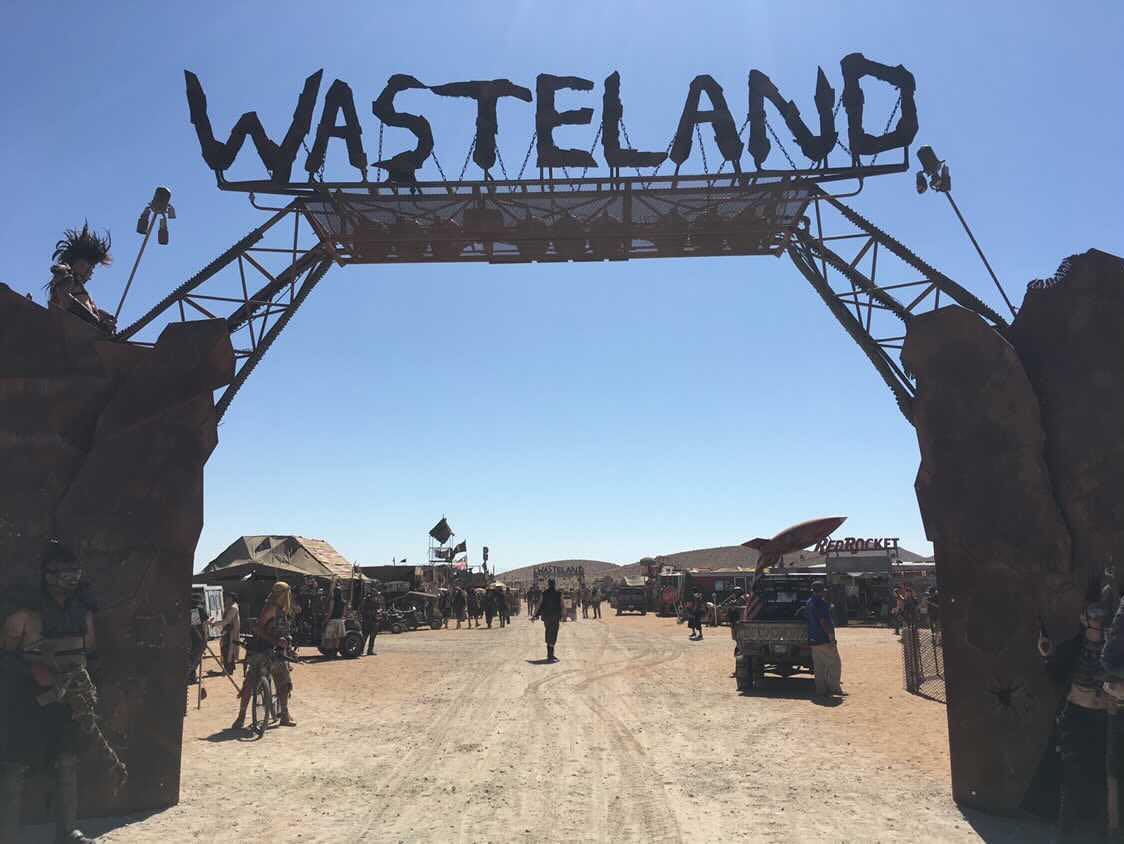
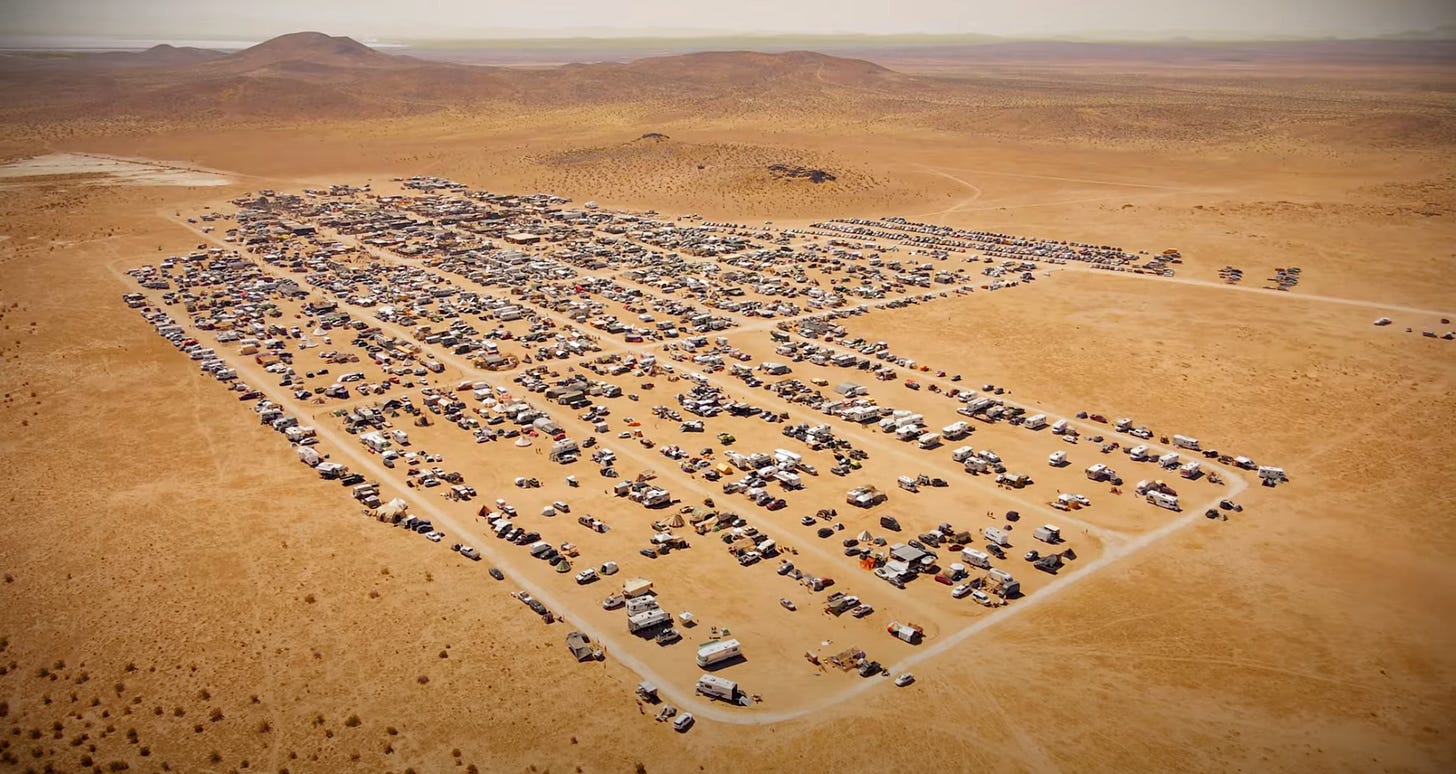
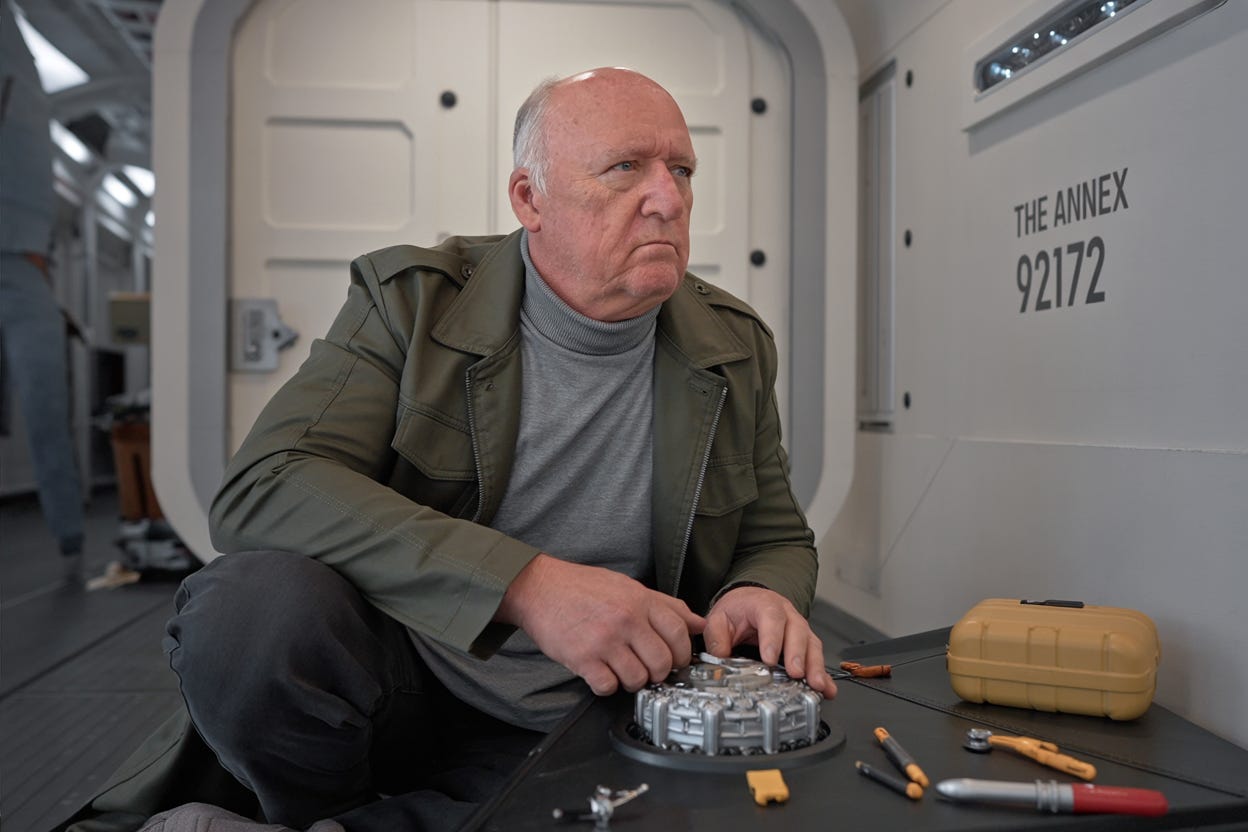
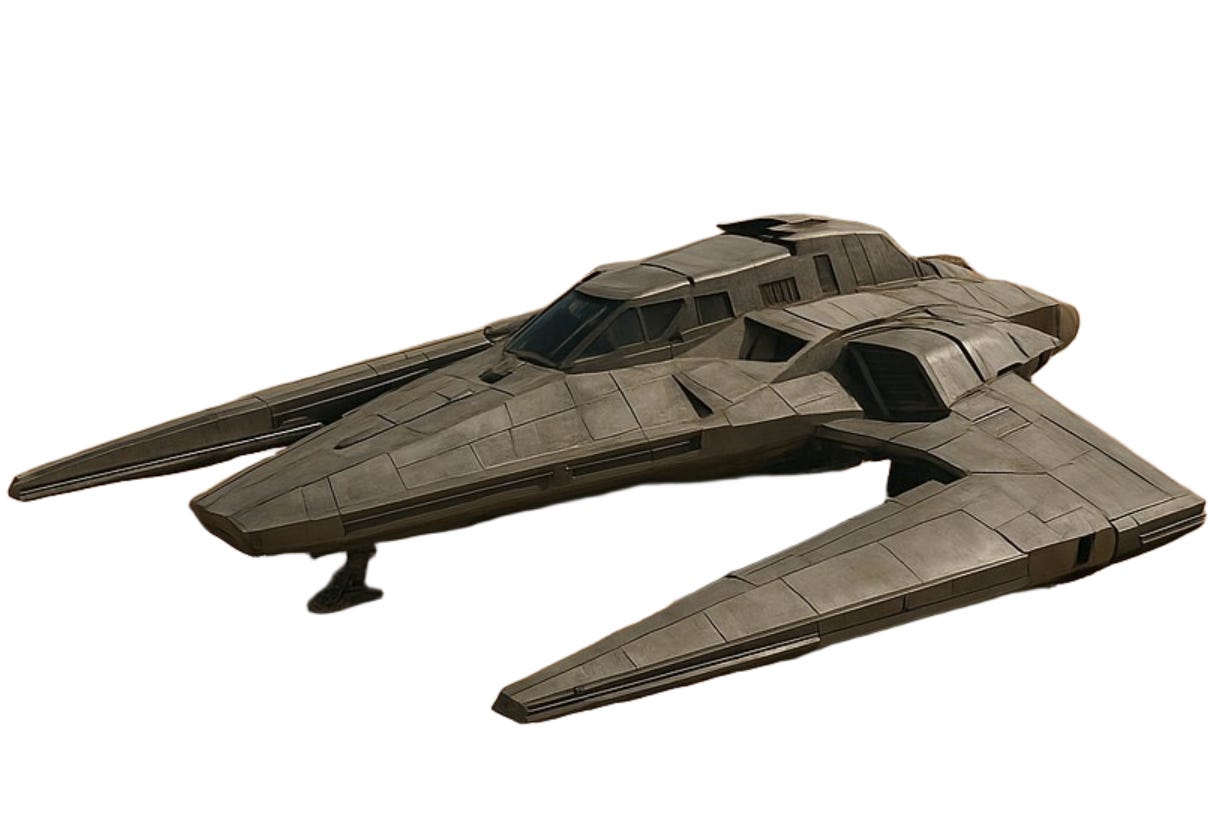
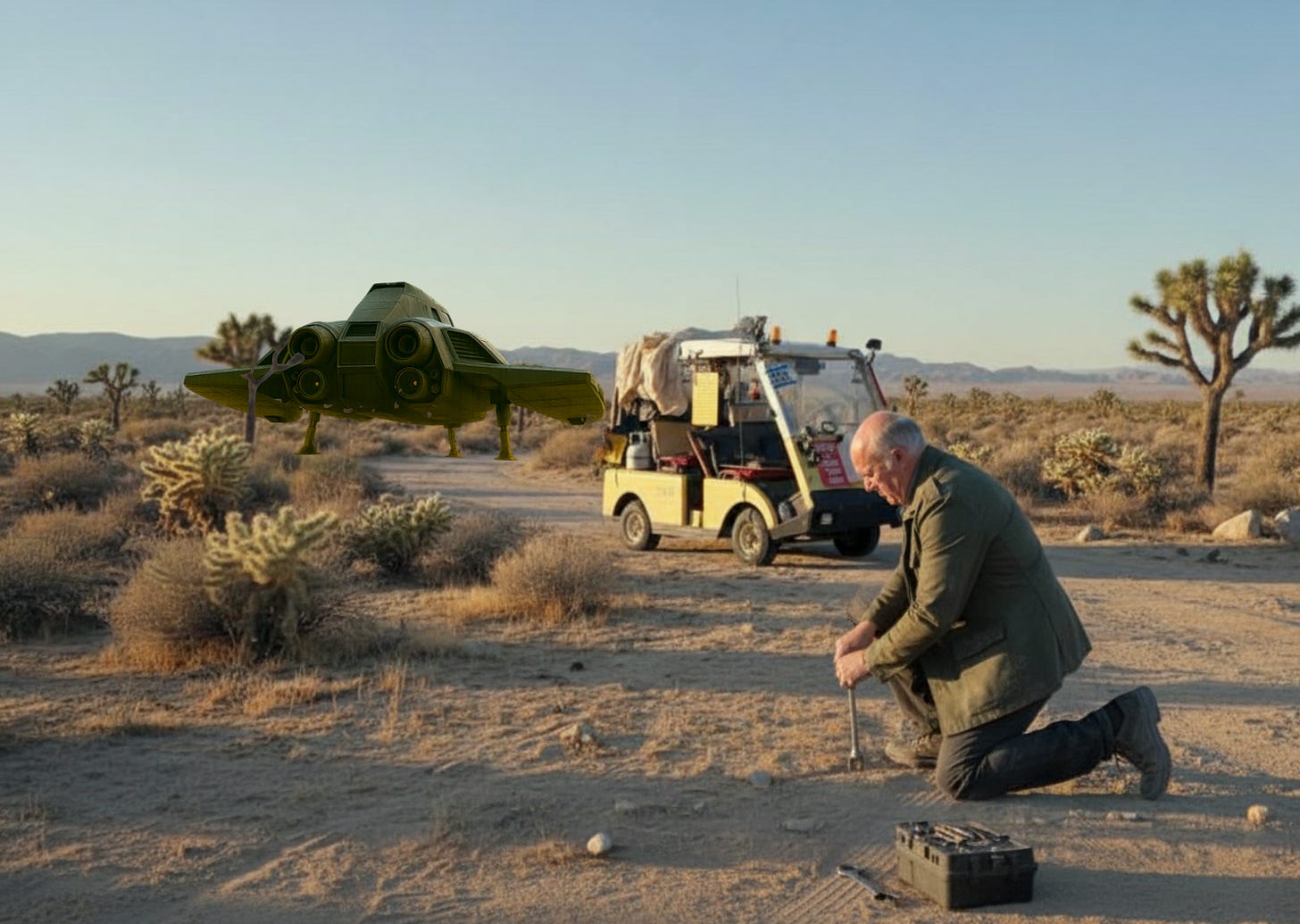
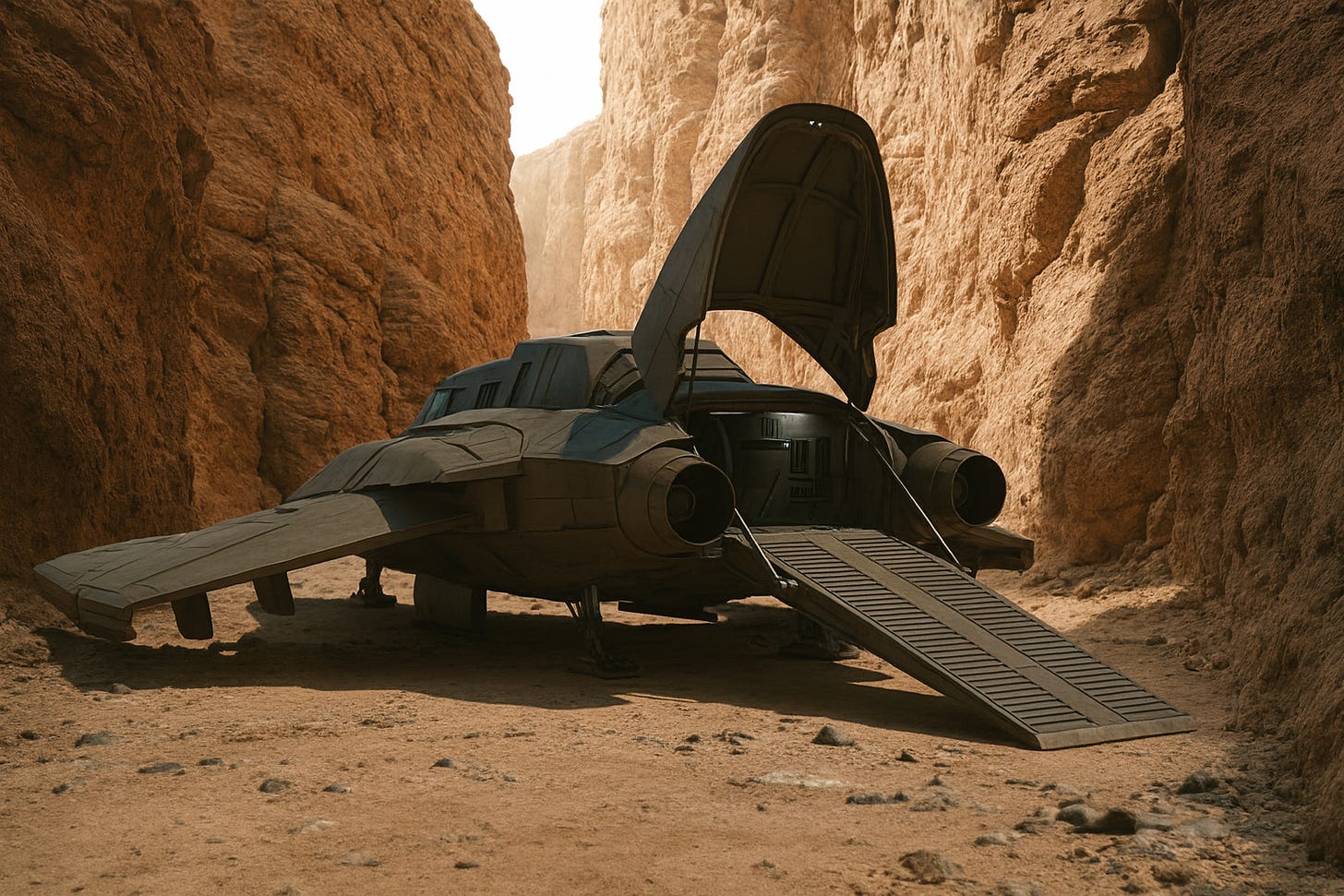
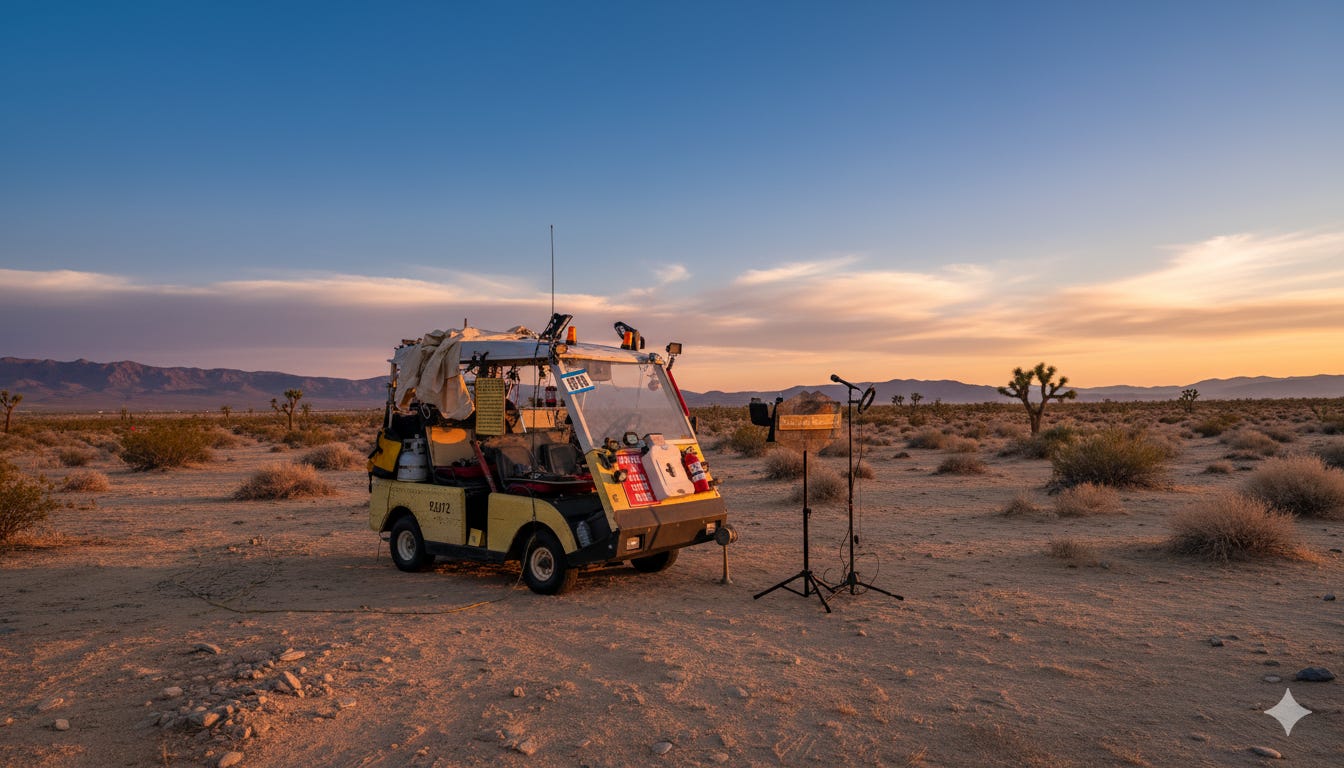
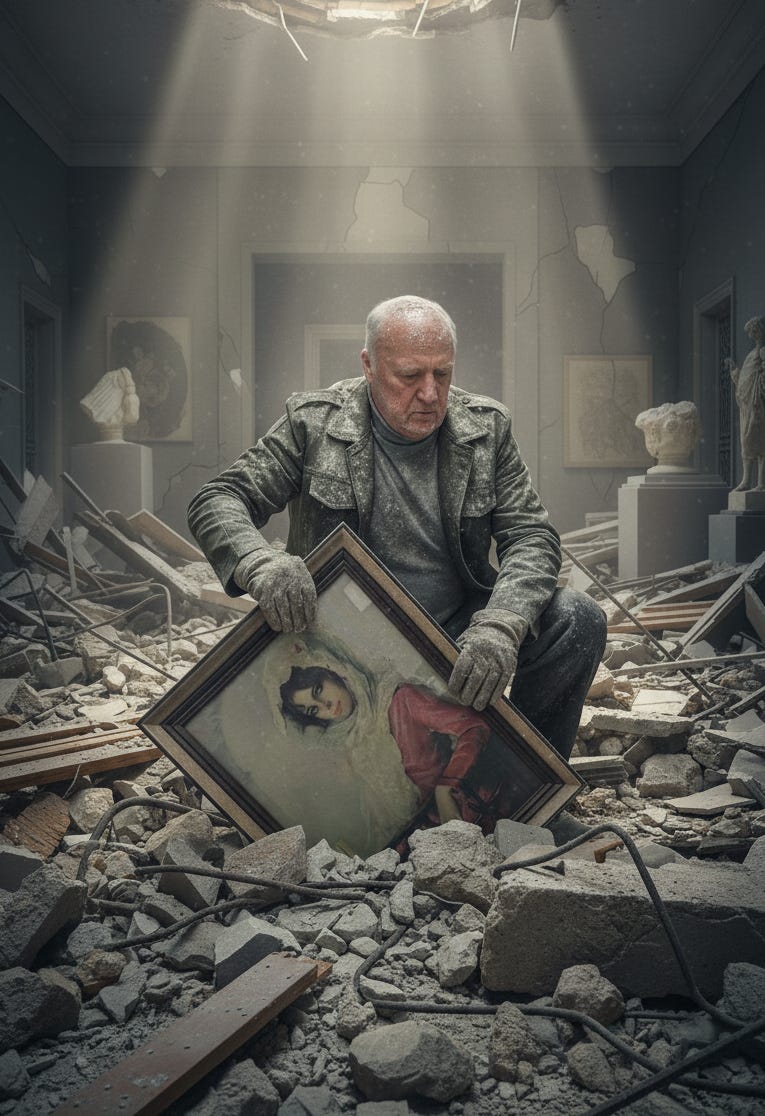
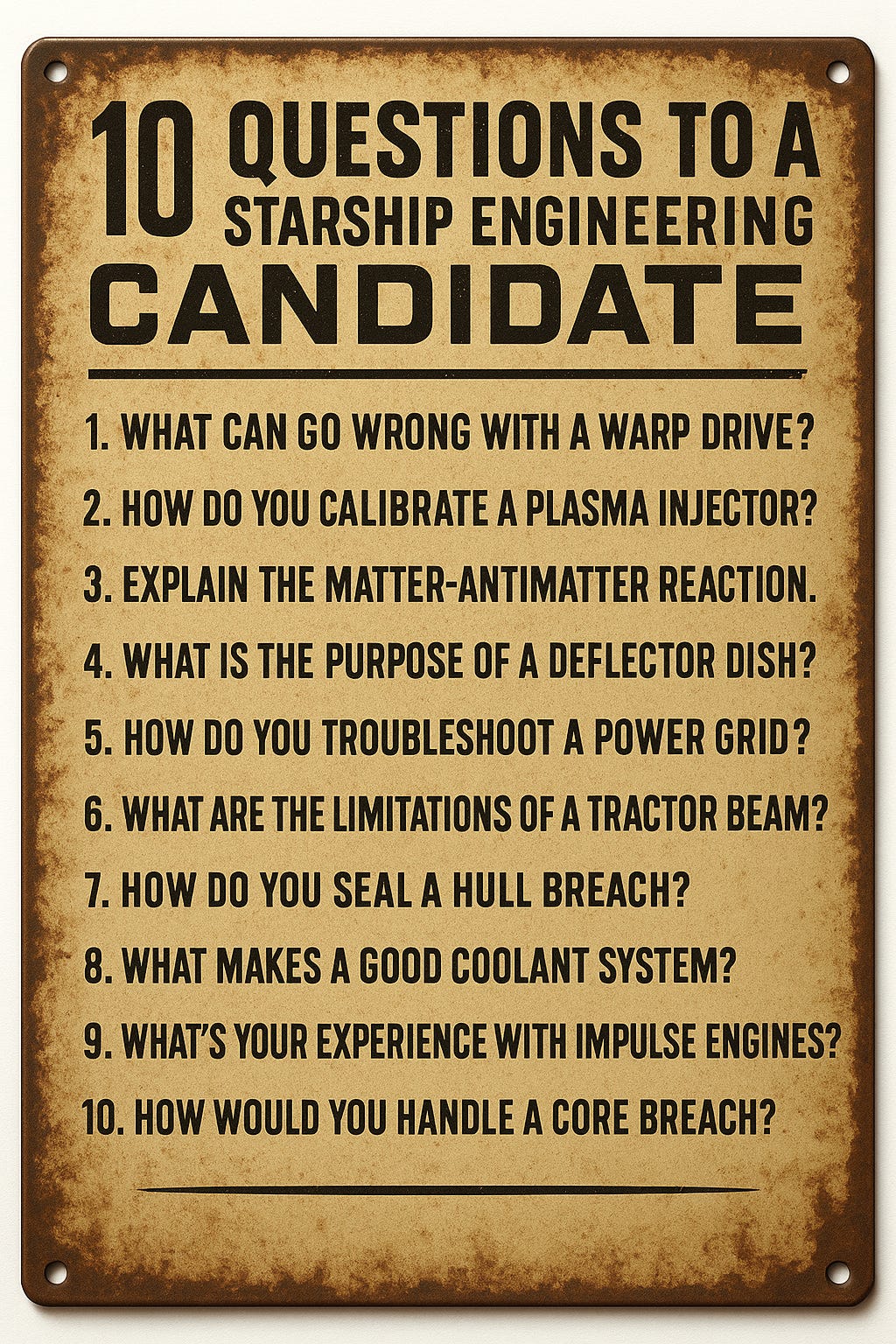
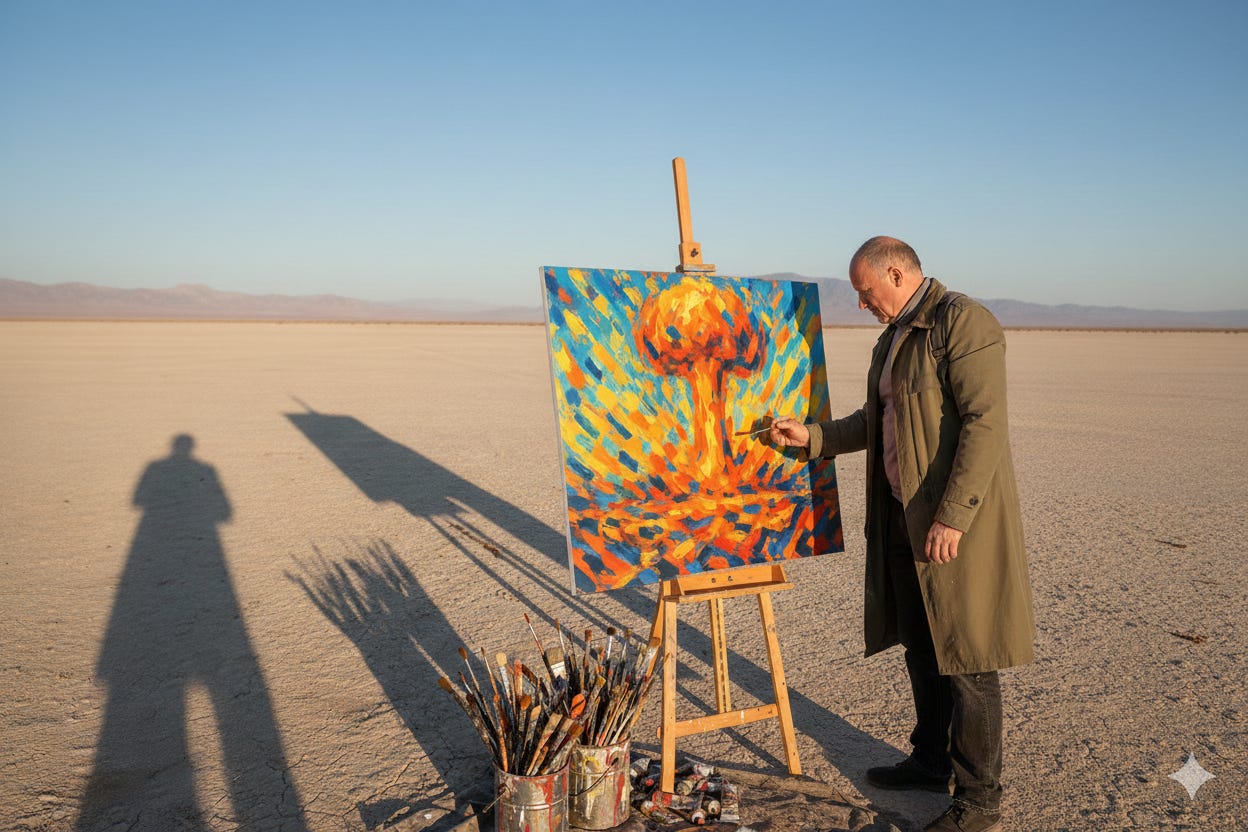
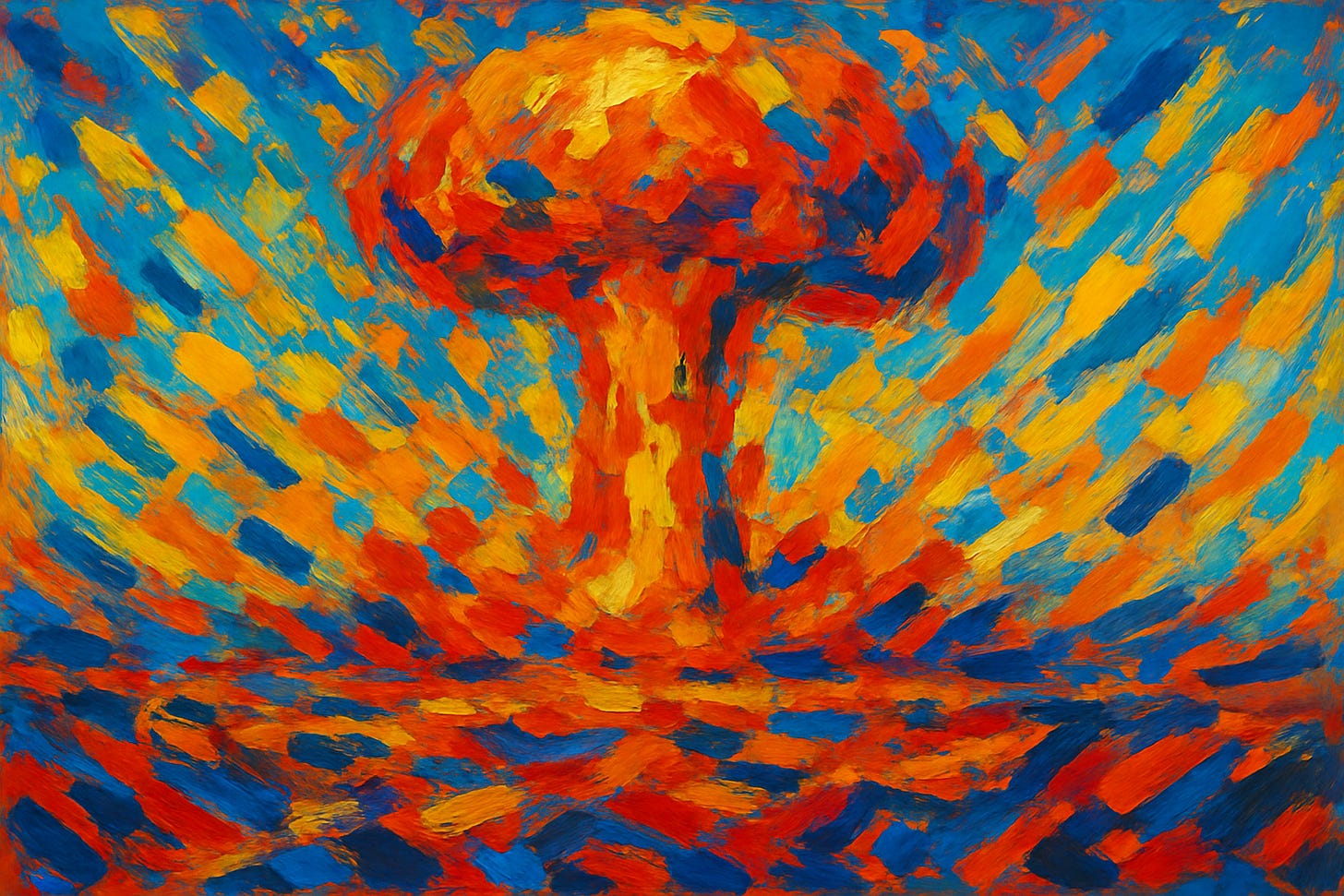
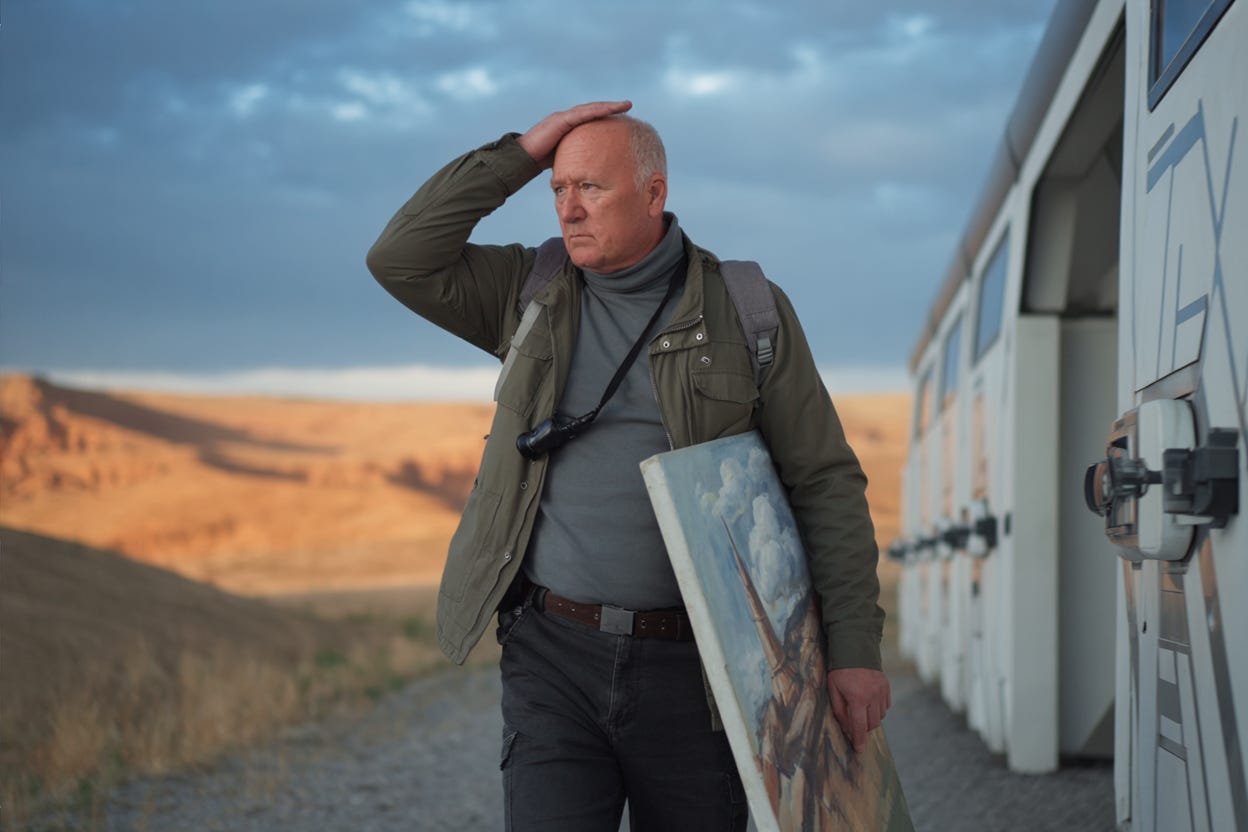

Good job Charles!